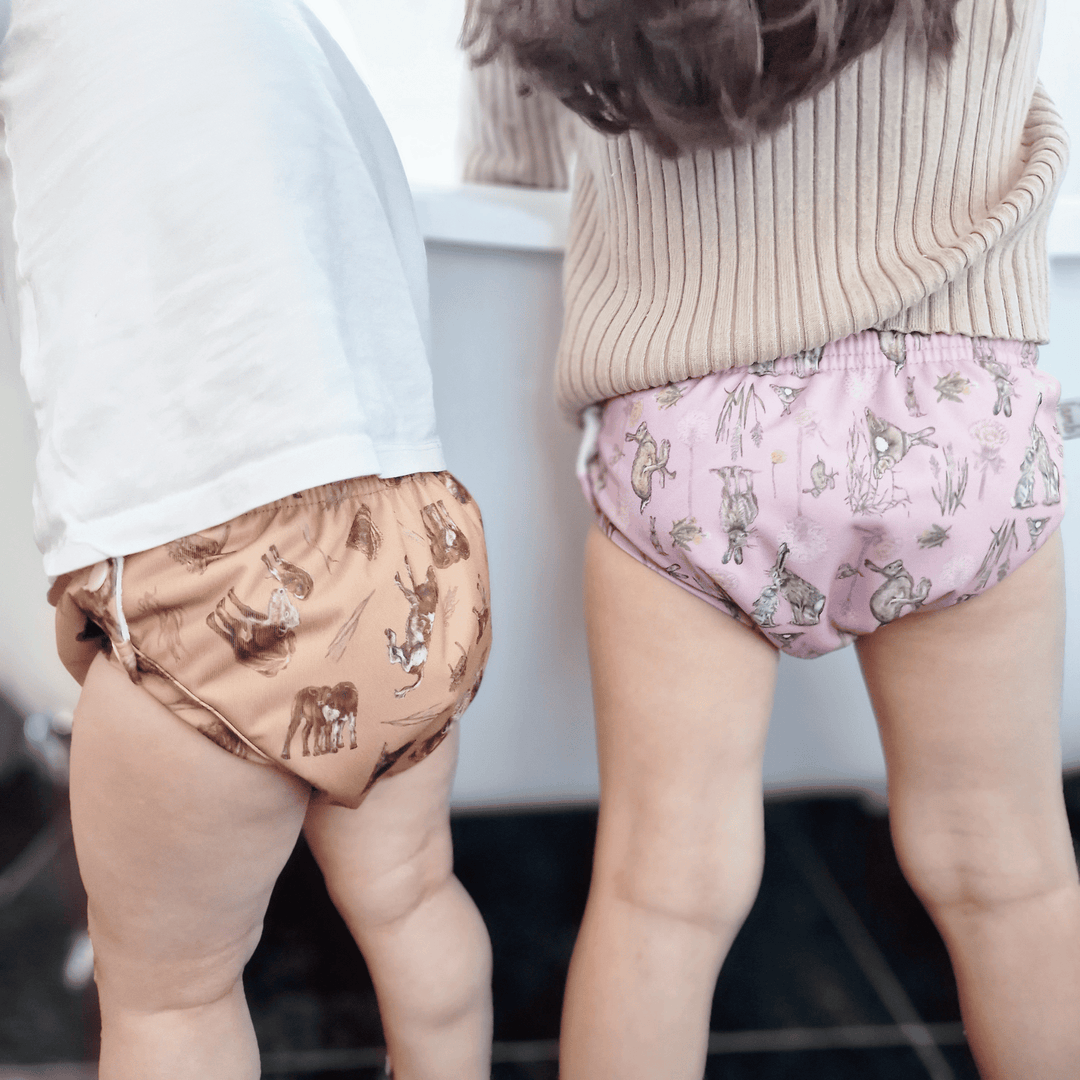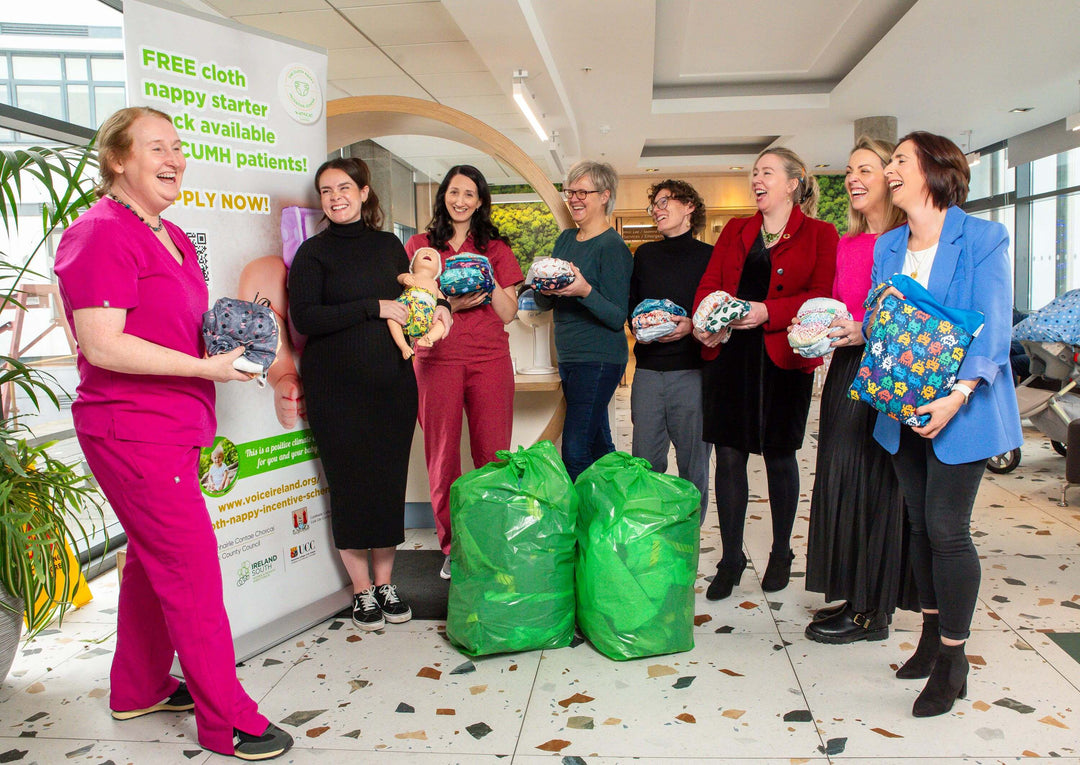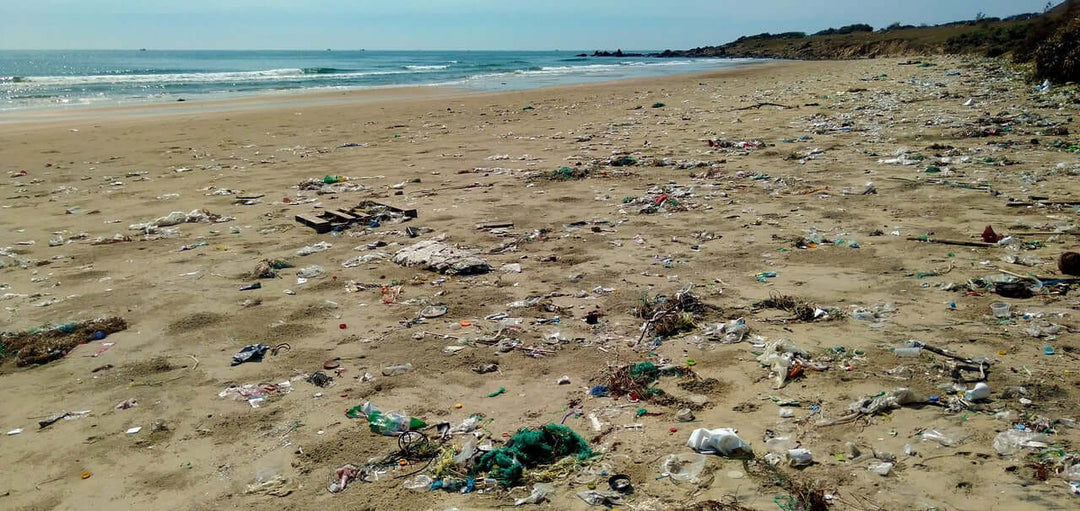Why should I choose cloth nappies?
Why Should I Choose Cloth Nappies?
Cloth nappies will save you a lot of money. This is an undisputed fact. Allow us to explain.
Every parent or guardian has a different motivation for using cloth nappies. Your rationale for wanting to use cloth nappies may be purely for environmental and sustainability reasons, however many parents are also moving towards reusable options to save money; a lot of money.

The Cost of Disposable Nappies
Disposable nappies are the biggest financial outlay for the vast majority of parents. An average child gets through 1,600 nappy changes per year before toilet training, which usually begins around the age of 3. When averaged over those 3 years, your little one will need 7 nappy changes per day and at an average of €0.20 per nappy which amounts to €1.40 per day, €511 per year, and €1533 for 3 years. Please bear in mind that bin charges would be additional to this.
The Cost of Reusable Nappies
For the following calculations it must be noted that we have included the cost of purchasing and washing reusable wipes. There are a growing number of parents who use cloth nappies also opting to use reusable wipes with their children. Should you too choose to use reusable cloth nappies, the addition of reusable wipes are an economical and environmental decision that will benefit you and your little one.
So let’s take a look at the realistic costs in more detail:
Should you wish to solely use cloth nappies, you will need a stash of roughly 25 nappies. Regardless of what type of cloth nappy system you opt for, this will amount to an outlay of about €330. When washing and drying costs are also factored in at the average Irish rate, a total cost for using just cloth nappies and wipes is €475.
It should be noted that truly phenomenal savings occur when families have further children. One customer told us that she used cloth nappies on all 6 of her children, and estimated with the cost of the nappies themselves and washing, she had spent €625. She also calculated the cost of using disposable nappies which would have come to an astonishing €8850!
Providing the cloth nappies have been correctly washed, dried, and stored, they should be perfectly reusable with further children without any degradation in quality. Please be aware however, should you consider utilising this as an option, it is worth considering about the durability of the nappy fastenings; cloth nappies that fasten with snaps typically have a longer lifespan than those that fasten with hook & loop closures.
Should you wish to try a no frills and cost effective option for reusable nappies, do check out our Birth to Potty Starter Pack. This is perfect for the parent who wishes to trial cloth nappies, and is available in packs of 5, 10, or 15. This will give you a great introduction to the world of cloth nappies, and should you wish to continue and invest in more, you can add to your stash if and whenever you need to.
Disposable Nappies and the Environment
It is estimated that 20% of parents in Europe use reusable nappies on their children, and while each of these parents are undoubtedly leaving to monetary savings, what impact are their actions having on the environment?
There has been a mixture of confusion and incorrect information regarding the environmental impact on the use of cloth nappies, and much of this stems from a discredited report in 2005 from the UK Environment Agency. It is important to note that this report on reusable nappies, which is readily available to view online makes multiple assumptions regarding both cloth and disposable nappies that are simply unrealistic and untrue. First, let us point out that not all nappies are washed at 90 degrees Celsius, in fact we have yet to come across a brand that recommends such a high washing temperature for reusable nappies. We strongly encourage you to always follow the manufacturer’s washing instructions, with most advising you to wash cloth nappies between 40 to 60 degrees Celsius. Second, not all nappies are tumble dried every second day. Most brands do allow for tumble drying, but they also advise against doing this daily as over time it can slowly damage the fabric that makes the nappies waterproof. Third, not all nappies need extended wash cycles. Most of loyal customers and indeed we ourselves do a wash every 3-4 days with a short pre-wash/rinse cycle at 40 degrees Celsius and then a longer, warm main wash at 60 degrees Celsius. You will find what is best for you and your reusable nappies.
The washing machines and dryers today are also significantly more efficient than those from two decades ago. These are simply undisputed facts. Since 2005, every major study of note has strongly encouraged the use of cloth nappies, including a detailed study from Zero Waste Europe in 2020, which is supported by the LIFE Programme of the European Union. A one size reusable nappy from birth to potty, is good for the environment.
We should also note that the 2008 update from the UK Environment Agency broadly arrived at the opposite conclusion to their previous report: reusable nappies are the more environmental choice by far if you wash and care for them properly. However, much damage had already been done. The 2005 report led to a generation of parents believing that reusable nappies produce just as much CO2 emissions through their life cycle from manufacturing to packaging to washing than disposables, or dismissed using cloth nappies altogether due to concerns over vastly increased water consumption, which again is factually untrue.

How are Disposable Nappies Manufactured?
The manufacture and packaging of disposable nappies for your baby has an ominously greater environmental impact than disposing of them. Multiple references cite that it takes over 1500 litres of crude oil to produce enough disposable nappies for one child. This is utterly ridiculous and simply unsustainable. It must also be noted that it takes 10 times more water to produce disposable nappies than the water used to wash reusable cloth nappies. Bear in mind that washing machines are becoming more efficient with each passing year, so these two numbers are even further apart. For most disposable nappies, wood pulp is the primary component and the production of this is both exceedingly water intensive and is often a source of deforestation and widespread soil impoverishment. By making the choice to convert to reusable nappies, the carbon footprint of each reusable nappy can be reduced by 50% (assuming a modern A+ rated washing machine/tumble dryer is used), which is the equivalent to 275kg of CO2 emissions over 3 years.
Waste Management of Nappies – Reduce, Reuse, Recycle
Your little one who uses disposable nappies will generate almost 850kg of nappy waste during its first three years of infancy, as many children require up to three years to grow out of nappies. It is easy to see why a whole new generation of parents are disturbed by such a figure and wish to switch to a reusable nappy.
If we here at Summer Sweets Baby can encourage just 25% of prospective parents to convert to using reusable nappies, and if this was reflected throughout the continent, the reduction of total waste in Europe would exceed 1.5 million tonnes per year. Throughout Europe, and it is certainly different per country, up to 92% of disposable nappies are sent to landfill. Just 8% are incinerated, however this often has an unfortunate negative impact on the environment since the incineration of plastics gives rise to pollutants that are high in toxicity. To choose cloth nappies is to choose for your baby’s future.
There is a growing movement worldwide towards reusable products, not just reusable nappies. Spurred by a determination to protect our planet and our pockets, fewer plastic straws, plastic bags, and disposable coffee cups are used in favour of metal straws, reusable bags, and reusable cups. This is just an example of everyday changes that are more common than ever, and it is critical to distinguish disposable nappies and wet wipes as single-use plastic products as well. A reusable nappy will last. Birth to potty nappies last. The best reusable nappies are made with this longevity in mind; a nappy has multiple parts: a waterproof outer layer or a waterproof cover, and a choice of absorbent inserts: microfibre, cotton, hemp, and bamboo.
Washing your Cloth Nappies
It is important to note the following calculations are for Ireland only. Cloth nappies, both the waterproof outer and inner layer, should be washed between 40 degrees Celsius and 60 degrees as per the manufacturers guidelines. However, when we consider the economic and environmental aspects of washing, we instantly consider price per wash. And this is a reasonable consideration to have. The modern nappy, especially pocket nappies should be separated prior to washing. A pocket nappy has two parts, and you should separate these prior to putting in your nappy bucket or washing machine.
For a modern A rated wash in Ireland it will cost roughly 7 cents per full load of nappies. It is obviously encouraged to ensure the drum is about ¾ full before running a cycle to allow for agitation and correct washing. Additionally, an Energy Star-Rated machine will incur a cost of just 5 cents per wash based on the use of 60 litres of water per cycle.
All the modern cloth nappies that we stock at Summer Sweets Baby are fabricated to dry quickly on a clothes line thus rendering a tumble drier unnecessary. This, of course, greatly reduces any implicit energy costs when we discuss reusable cloth nappies. However, for the purpose of our calculations for ultimate cost savings, we always assume that parents will predominantly use tumble dryers as this is often a necessity with the Irish weather.
And remember, as per the updated Environment Agency report of 2008, if every baby used one size reusable nappies, it would add just 1% to direct household water consumption.
Are Biodegradable Disposable Nappies Eco-Friendly?
As you research which option is best for you and your family, you will see many mentions of single-use nappies marketed as ‘biodegradable nappies’ or referred to as ‘eco-disposables.’ Please allow us to state that these terms are misleading and often untrue. When it comes to pros and cons with eco-disposables, there are only cons for babies. This type of ‘eco-friendly disposable’ nappy will largely contain a mix of materials which require different environments in order to degrade, thus they simply cannot do so under typical landfill conditions. We must also point out that they cannot they be placed in any regular compost bin. Whilst the production of these nappies are considered to have a marginally improved production cycle, they are regrettably still exceedingly likely to end up in precisely the same location as a regular disposable nappy – a landfill. This will essentially undo all the supposed benefits of this type of nappy.
But these nappies do have a place in our lives. We must be realistic with our baby and their needs. Very rarely will a parent or a guardian always have a cloth nappy available, and parents may need to buy disposables for their babies. When a child visits another home, disposables may be required. We understand and appreciate this fact. Many parents will therefore assess their situation, and will decide to have a small stash of biodegradable disposable nappies to hand as a somewhat eco-friendly option should the need arise for their babies.

Summary – One Step at a Time, One Reusable Nappy at a Time
“We don’t need a handful of people doing zero waste perfectly. We need millions of people doing it imperfectly.”
We are here for you and your baby. This is your decision and your journey. And we always encourage parents and guardians to adapt the use reusable cloth nappies to their lifestyle. But remember, every single nappy change with a cloth nappy is one less disposable cloth nappy in a landfill or an incinerator, and that is undoubtedly a positive step for the environment and for your pocket. This need not be a daunting undertaking.
You don’t have to use cloth for every nappy change.
You don’t have to use them overnight on your baby.
You don’t need to buy multiple brands.
Used nappies are just different nappies; the waterproof layer and absorbent inner should still be worthy of preventing leaks.
Don’t be discouraged by leaks with your baby.
Talk to your local nappy library.
You don’t have to send your baby to creche, to their grandparent’s house, or have a day out and worry about using and storing cloth nappies if it seems too much.
No parent should ever feel intimated or beleaguered about using reusables on their baby. You should never feel discouraged by unsolicited advice from friends and family or others who may choose to use cloth on their babies to save money or save the environment. Every child is different, every family is different, and every situation is different. We’ve all been there and have seen the abbreviations and cloth ‘lingo’ that may not make any sense. Do not worry. This is certainly easier than it seems at first and we are always here to help with any questions you may have, queries about our pocket nappies or birth to potty kits for your baby, what’s best for your baby’s skin, and will guide you if that is what you need. We are here, no pun intended, at your disposal.




